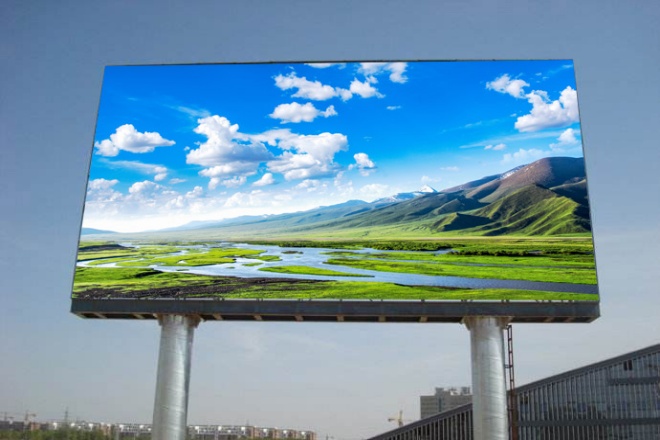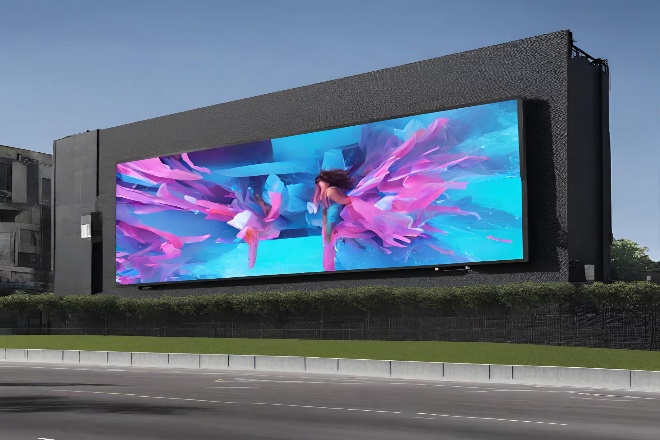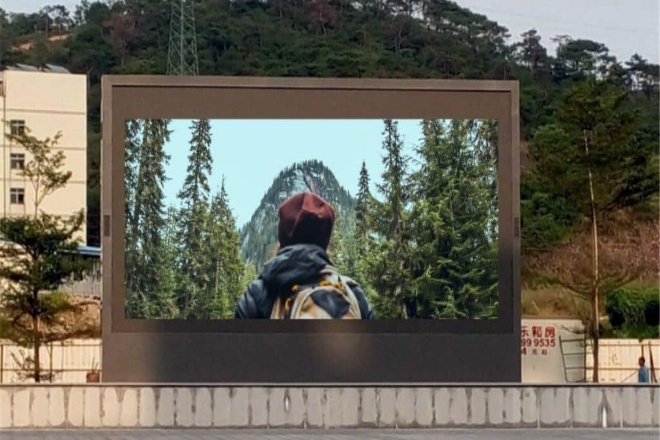Introduction

We all know that the application environment of écrans LED extérieurs is not easy to control; sometimes, it is very hot, and sometimes it is very cold.
Therefore, in the face of the changing outdoor environment, outdoor LED displays will also have some coping measures, such as installing air conditioners to control the temperature inside the LED display.
But how to judge whether your outdoor LED display needs to be installed with air conditioners? Read the article to teach you how to do it.
1. Analysis of the working environment of outdoor LED display

1). Natural environmental factors:
Outdoor LED displays are like the “big eyes” in the city, always staring at passers-by and conveying various information. But they are not so “weak” and have to face all kinds of weather in nature.
High temperature: In the hot summer, the small parts of the LED display are also afraid of heat. If it is too hot, it may “strike” or “short-lived”.
Low temperature: In winter, the wind is cold, and the wind is biting. Although the LED display is not like ours, which will freeze, it may not start or work smoothly if it is too cold.
Humidité: Wet weather is the most troublesome. If moisture enters the LED display, it will be troublesome. Short circuits and corrosion may come to the door.
Wind and sand: When the wind and sand are strong, the LED display is like being polished with sandpaper. There may be scratches on the surface, and even sand will get into the display to cause trouble.
Rain: On rainy days, although the LED display has a waterproof function, long-term rain erosion and soaking will still make it “injured,” especially when the waterproofing is not done well or maintenance is not timely.
2). Working temperature range:
Each LED display has its own “comfort zone”, which is the temperature range that is most suitable for it to work. This range is generally from -20℃ to +50℃, but this range will also be different for different brands and models of displays.
If the working environment temperature of the LED display exceeds this “comfort zone,” you must be careful:
- Performance decline:
If the temperature is too high or too low, the display effect of the LED display will be greatly reduced, the color will not be so bright, the brightness will not be enough, and it will not look so attractive.
- Poor stability:
Once the temperature is unstable, the LED display may start to be “wrong,” flickering, screen distortion, or even black screen, which is a headache.
- Shortened lifespan:
If the LED display works at an unsuitable temperature for a long time, its “lifespan” will be greatly reduced, and it may have to be replaced soon.
Therefore, when choosing an outdoor LED display, you must consider the natural environment it will face, and think about how to “keep warm” or “cool down” it so that it can work steadily in all kinds of weather.
2. What is the role of air conditioning in outdoor LED displays?
Although outdoor LED display is tough, it sometimes needs a little “special care” in the face of the “test” of nature. At this time, the air conditioner plays the role of “guardian” and provides all-round care for the display.
1). Temperature regulation:
Just as we need to work in a comfortable environment, the LED display also has its “comfortable temperature.” The air conditioner can keep the internal temperature of the display stable by cooling or heating, avoiding performance degradation or damage due to overheating.
Imagine that in the hot summer, the air conditioner is like sending a breeze to the display screen, allowing it to work “calmly”; in the cold winter, the air conditioner is like putting a warm “coat” on the display screen to protect it from the cold.
2). Humidity control:
Humidity is another “natural enemy” of outdoor LED display screens. Excessive humidity can cause condensation inside the display screen, which may cause problems such as circuit short circuits and corrosion.
The air conditioner can effectively reduce these hidden dangers by adjusting the indoor humidity and creating a dry and safe working environment for the display screen. In this way, the display screen can work more “healthily,” and its service life will be greatly extended.
3). Dust and insect prevention:
Dust and insects are inevitable in outdoor environments. If these “uninvited guests” are allowed to enter the interior of the display screen, it will not only affect the display effect but may also cause damage to electronic components.
The closed design of the air conditioner is like putting on a layer of “protective clothing” for the display screen, which can effectively prevent the entry of dust and insects. In this way, the display screen can keep its interior clean and tidy and work more smoothly and stably.
3. Not all outdoor LED displays require air conditioning

After reading the above, you may think that outdoor LED displays and air conditioning seem to be “standard,” but this is not the case.
With the advancement of technology and the diversity of actual situations, we find that not all outdoor LED displays require air conditioning to “escort.”
1). Technological progress:
Modern outdoor LED displays have put a lot of effort into design. They use more advanced heat dissipation technology and materials, such as putting “sunscreen” and “raincoats” on display.
These technologies improve the display’s resistance to high temperature and moisture, allowing the display to maintain stable performance in harsh environments. Therefore, for some technologically advanced displays, additional air conditioning equipment may be redundant.
2). Differences in installation environment:
The installation environment of outdoor LED displays varies greatly. Some places have good shading effects, some places have good ventilation, and some places have mild climates. Under these conditions, the display may not need additional air conditioning to adjust the temperature or humidity at all.
For example, in some cities, although it is cold in winter, the display is installed in a sheltered place, and its own insulation design is enough to cope with the low-temperature environment. Therefore, the installation of air conditioning needs to be flexibly decided according to the specific installation location and climatic conditions.
3). Cost considerations:
The installation and maintenance costs of air conditioners are not a small amount. For projects with limited budgets, installing air conditioners may add unnecessary financial burdens.
Moreover, if the display itself has strong environmental adaptability, then installing additional air conditioners seems a bit “luxurious.” Therefore, when deciding whether to install air conditioners, we also need to consider cost factors, be thrifty, and make reasonable investments.
4. How to determine whether to install air conditioners?
When you are at the crossroads of whether to install air conditioners for outdoor LED display screens, don’t rush to make a decision.
First, do a comprehensive “physical examination” to ensure that your choice is both scientific and economical.
1). Environmental assessment:
First, you have to give the installation site a comprehensive “climate diagnosis.” See how the temperature changes in this place throughout the year, how hot it is in summer, how cold it is in winter, whether it is humid, and whether there is much wind and sand. These natural environmental factors are key factors that directly affect the “health” of the display.
If the installation site often encounters extreme weather, such as the temperature in summer often reaches around 45-50 degrees or the temperature in winter often drops to below zero, then installing air conditioners is very necessary. But if the climate is mild and spring-like all year round, then maybe you can save this expense.
2). Display screen specifications:
Next, you have to look at the “physical fitness” of the display screen itself. Power, luminosité, and heat dissipation design are all important indicators for evaluating the natural heat dissipation capacity of the display screen.
If the display screen has high power and high brightness, it will definitely generate a lot of heat, and at this time, a better heat dissipation system is needed to “cool down.”
But if the display screen has taken heat dissipation into consideration in its design, such as using advanced heat dissipation materials and technologies, then it may have enough “self-regulation” ability and does not need additional air conditioning to help.
3). Usage requirements:
Finally, you have to think about the “workload” and “importance” of the display screen. If the LED display screen is used frequently and for a long time, such as commercial billboards or traffic information display screens, then it needs a more stable working environment to ensure the accurate transmission of information.
At this time, it is necessary to install an air conditioner. But if the LED display screen is only used occasionally or is not very important, then maybe you can “make do” with it and don’t have to install an air conditioner.
5. Alternative solutions and energy-saving measures

Outdoor LED displays are a beautiful sight in the city, but their energy consumption is also a headache. Don’t worry. We have a few tips that can make the display screen “live” better outdoors and save a lot of electricity. Let’s take a look!
1). Natural heat dissipation easy to deal with
Is the display too hot? You have to “wear” heat-dissipation “clothes” for it. Materials with super good thermal conductivity, such as aluminum heat sinks, can be used to make part of the shell so that the heat can be quickly dissipated into the air.
Add a few small fans to force airflow, and the heat dissipation effect is also good! Of course, the air outlet and air inlet must also be designed well to allow air circulation and not block it.
2). Intelligent temperature control, save power and worry
Is the brightness of the LED display too high and dazzling? You have to make it “smarter” and automatically adjust the brightness according to the outside environment.
For example, it will automatically dim when it gets dark and light up when it gets light, which saves power and protects the eyes.
There is also the multi-level grayscale correction technology, which makes the color transition more natural, makes it look more comfortable, and can also reduce light pollution and energy consumption!
3). Sunshade protection, two-pronged approach
Are you afraid of the sun and rain on the display? You can “hold an umbrella” for it. Install a sunshade or reflective material to block direct sunlight and make the display look brighter. At the same time, it is also necessary to do a good job of waterproofing and moisture-proofing.
The interface and the shell must be sealed well to prevent rain from getting in. It is also important to clean the water on the back and around the display regularly and keep it dry!
Conclusion
In summary, whether the outdoor LED display needs to be installed with air conditioning requires careful consideration of technology, environment, cost, and usage requirements. With the advancement of technology, more and more display screens can operate stably in an air-conditioned environment.
Therefore, when making decisions, we should make a comprehensive assessment and actively explore efficient heat dissipation technology to achieve green and intelligent outdoor displays.
Enfin, si vous souhaitez en savoir plus sur les écrans d'affichage LED, veuillez nous contacter.
